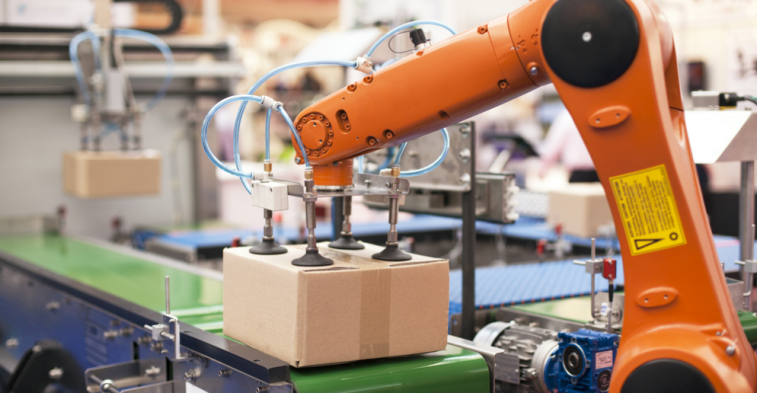Eliminate Pneumatic Hassles Once and for All
Many warehouse automation systems are driven by the pneumatic energy of pressurized air. They’re often found in shoe sorters, which use pneumatic cylinders to actuate switch blocks. They’re also common in narrow-belt accumulation conveyors.
Read also: The Top 5 Inexpensive Warehouse Automation Solutions
At first glance, pneumatics seem like an easy and low-cost solution. There’s nothing fancy or magical about the technology. Parts are inexpensive and easy to find. Even if you can’t get the exact valve made by the original manufacturer, any vendor that sells similar parts can provide something suitable. Troubleshooting is also easy, at least in theory.
In real-world applications, however, the complexity of pneumatic systems makes them extremely inefficient — and there are many ways they can fail.
Let’s “Air” a Few Grievances
Pneumatic systems are complicated and require a vast number of parts. This makes them difficult to install and inefficient to operate. Estimates vary, but some suggest that pneumatic equipment only makes effective use of about 5 to 10% of the energy required to run them.
A lot of that energy goes into powering the compressor that pressurizes the air. These units are typically located outside or isolated away from the equipment they run. They generate so much noise and heat that no one wants to work anywhere near them. If you’re installing a large system, or plan to expand the system later, you’ll need to make sure your compressor is powerful enough to provide the airflow required.
Regular care and maintenance of the compressor are essential to keep the air clean and dry. Unfortunately, they’re also very expensive. As a result, many operations let air quality slide. Over time, dust accumulates inside cylinders and valves, causing a system to lose efficiency, energy, and speed.
A compressor failure will obviously mean costly unscheduled downtime, but even a tiny air leak can bring an entire system down. If you’ve ever tried to sip a drink through a broken straw, you’ve experienced a similar problem. Now imagine that straw is several miles long, twisting and turning throughout an entire warehouse and branching off in multiple directions. A leak anywhere in that line can cause airflow loss throughout the entire system — without giving you any idea where it is.
Pressurized air also makes a lot of noise, like the sound you hear when a kneeling bus lowers to make it easier for passengers to board. Although some pneumatic cylinders have components designed to help reduce this noise, they’re still loud. Every time you actuate, you’re going to hear it.
Technological Disadvantages Put Downward Pressure on Your Business
Air systems provide no speed or position controls. Although most pneumatic units have an end-of-line switch that will tell you whether the cylinder was extended, you have no way of knowing what’s happening between the beginning or end of the motion. This means there’s no early warning if a cylinder’s performance is declining. You won’t know there’s a problem until it breaks, potentially causing unscheduled downtime.
Pneumatics are also slow compared to other technologies. The only way to increase the speed of a cylinder is to increase the airflow. The upper limit you can achieve in this way is generally much lower than with electrical activations. That’s becoming somewhat of an issue, as distribution centers are under growing pressure to increase throughput more than ever before.
Are Electric Alternatives the Answer?
Electric solutions have many advantages over pneumatics, including easier installation and maintenance, superior performance, quieter operation, and more consistent reliability. They also make it easier to scale at your own pace.
Adding a new conveyor to a pneumatic system, for example, often requires a larger compressor plus all the new airline runs. By contrast, expanding an existing electric system is more likely to be a “plug-and-play” operation. You can install new equipment with little or no extra infrastructure. In addition, you can start small without having to worry about oversizing a compressor to support future upgrades.
Let’s review the pros and cons of three electric alternatives to pneumatics: solenoids, servomotors, and Solligence™ fast rotary actuators.
Solenoids
Solenoids allow faster activation times and offer a good balance of performance and cost. They’re small, inexpensive, low maintenance, and typically require only a pair of cables. If something goes wrong, they can be replaced quickly with minimal cost and downtime.
Like pneumatic cylinders, electric solenoids don’t have speed or position control. You’ll need to put a sensor somewhere if you want to know what it’s doing.
Solenoids also need to be managed by an external controller and require large power supplies to achieve their higher speeds. The size of the power supply needs to be optimized to provide the right burst of energy. Too little power and the solenoid won’t function at the desired speed. Too much and you can burn the unit out.
Servomotors
Servomotors in warehouse automation are a lot like sports cars. They’re the fastest solution on the market, with precise control over speed and position. A built-in encoder provides visibility and smart feedback.
Like sports cars, however, servomotors and the controls that drive them are extremely expensive. They need large power supplies, complex software, and are complicated to configure properly. Together, these disadvantages make them cost-prohibitive for most warehouse applications.
Solligence Fast Rotary Actuators
Johnson Electric developed Solligence to leverage many of the technologies previously found only in servomotors into a simple electric solenoid. This combination overcomes the disadvantages of both options — as well as long-standing industry performance limits — while simplifying installation and reducing operational costs.
An integrated drive unit eliminates the needs for an external driver, control box, and assembly labor. Low voltage and current requirements reduce installation and energy costs, enabling narrower-gauge wire and smaller, less expensive power supplies to be used. Integral on-board energy storage allows power to be slowly “sipped” from the main bus during the entire cycle, actuating the solenoid with bursts of power to generate high velocity as needed.
Solligence continuously monitors changes in motion duration, adjusting the drive profile as needed to continue meeting specifications. The unit also triggers an alert when it detects wear, preventing costly unplanned downtime.
Weigh the Pros and Cons Holistically
Although low capital costs continue to make pneumatics popular, the costs of operating and maintaining these inefficient systems can quickly outpace your initial savings. It’s therefore no surprise that a growing number of the world’s leading logistics operations are turning to electric alternatives. They’re ready to be done with the downtime risks, operational costs, and other hassles of pneumatics.
Whether you choose traditional solenoids or innovative Solligence fast rotary actuators, electric alternatives deliver cost and performance advantages pneumatics simply can’t match. You’ll benefit from faster, more reliable automation that won’t leave you gasping in frustration.





Leave a Reply